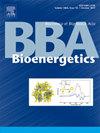不同高氧诱导急性肺损伤易感性大鼠肺组织线粒体活性氧生成的研究。
IF 2.7
2区 生物学
Q2 BIOCHEMISTRY & MOLECULAR BIOLOGY
引用次数: 0
摘要
暴露于高氧(bbb95 % O2)的成年大鼠在60-72 小时内死于呼吸衰竭。然而,当用bbb95 % O2预处理48 小时,然后在室内空气(h - t)中预处理24 小时,或用60 % O2预处理7 天(h - s)时,它们分别获得了对高氧的耐受性或易感性。目的是量化H2O2的产率,并确定正常缺氧、H-T和H-S大鼠离体肺线粒体和离体灌注肺(IPLs)中H2O2的来源。从肺中分离线粒体,并在丙酮酸-苹果酸盐或琥珀酸盐存在的情况下量化H2O2的产率,以及是否有线粒体复合体I (CI),复合体II (CII)和/或H2O2清除系统的抑制剂。采用CII抑制剂和不采用CII抑制剂的IPLs,定量测定H2O2的肺释放速率。分离线粒体的结果表明,CII是H2O2的主要来源,H-S线粒体的H2O2产率和清除能力比常氧条件下低~48 %。IPLs结果显示,CII也是肺组织中H2O2的主要来源,H-T肺中H2O2的释放率低于常氧肺和H-S肺。这些结果表明,H-S大鼠的线粒体产生H2O2的速率和清除能力都明显低于正常氧条件下的线粒体,这可能是其高氧敏感性增加的原因。H-T ipl较低的H2O2释放率,以及线粒体H2O2生成速率未发生变化,与H-T大鼠肺部较高的抗氧化能力一致,这可能有助于其高氧耐受性。本文章由计算机程序翻译,如有差异,请以英文原文为准。

Mitochondrial reactive oxygen species production in lungs of rats with different susceptibilities to hyperoxia-induced acute lung injury
Adult rats exposed to hyperoxia (>95 % O2) die within 60–72 h from respiratory failure. However, when preconditioned with either >95 % O2 for 48 h followed by 24 h in room air (H-T) or 60 % O2 for 7 days (H-S), they acquire tolerance or susceptibility to hyperoxia, respectively. The aim was to quantify H2O2 production rate and identify sources in isolated lung mitochondria and isolated perfused lungs (IPLs) of normoxia, H-T, and H-S rats. Mitochondria were isolated from lungs, and H2O2 production rates were quantified in the presence of pyruvate-malate or succinate, with and without inhibitors of mitochondrial complex I (CI), complex II (CII), and/or H2O2 scavenging systems. Lung rate of H2O2 release was quantified in IPLs with and without CII inhibitor. Results from isolated mitochondria show that CII is the main H2O2 source, and that both H2O2 production rate and scavenging capacity were ~48 % lower in H-S mitochondria compared to normoxia. Results from IPLs show that CII is also the dominant H2O2 source from lung tissue, and that H2O2 release rate was lower in H-T lungs compared to normoxia and H-S lungs. These results suggest that for H-S rats, both mitochondrial rate of H2O2 production and scavenging capacity were significantly lower than those in normoxia mitochondria and may contribute to their increased hyperoxia susceptibility. The lower H2O2 release rate from H-T IPLs, along with no change in mitochondrial H2O2 production rate, is consistent with higher antioxidant capacity in the lungs of H-T rats, which may contribute to their hyperoxia tolerance.
求助全文
通过发布文献求助,成功后即可免费获取论文全文。
去求助
来源期刊

Biochimica et Biophysica Acta-Bioenergetics
生物-生化与分子生物学
CiteScore
9.50
自引率
7.00%
发文量
363
审稿时长
92 days
期刊介绍:
BBA Bioenergetics covers the area of biological membranes involved in energy transfer and conversion. In particular, it focuses on the structures obtained by X-ray crystallography and other approaches, and molecular mechanisms of the components of photosynthesis, mitochondrial and bacterial respiration, oxidative phosphorylation, motility and transport. It spans applications of structural biology, molecular modeling, spectroscopy and biophysics in these systems, through bioenergetic aspects of mitochondrial biology including biomedicine aspects of energy metabolism in mitochondrial disorders, neurodegenerative diseases like Parkinson''s and Alzheimer''s, aging, diabetes and even cancer.
 求助内容:
求助内容: 应助结果提醒方式:
应助结果提醒方式:


